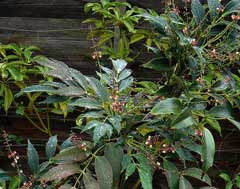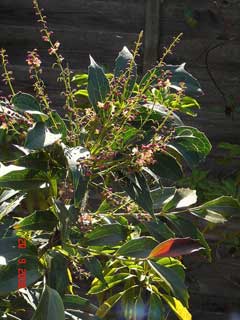 |
|
http://www.flickr.com/photos/peganum/ |
 |
| http://www.flickr.com/photos/peganum/ |
Translate this page:
Summary
Physical Characteristics

 Mahonia gracilipes is an evergreen Shrub growing to 1.5 m (5ft) by 2 m (6ft).
Mahonia gracilipes is an evergreen Shrub growing to 1.5 m (5ft) by 2 m (6ft).
See above for USDA hardiness. It is hardy to UK zone 7 and is not frost tender. It is in leaf all year. The species is hermaphrodite (has both male and female organs) and is pollinated by Insects.
Suitable for: light (sandy), medium (loamy) and heavy (clay) soils and can grow in heavy clay and nutritionally poor soils. Suitable pH: mildly acid, neutral and basic (mildly alkaline) soils. It can grow in full shade (deep woodland) or semi-shade (light woodland). It prefers moist soil.
UK Hardiness Map
US Hardiness Map
Synonyms
Plant Habitats
Woodland Garden Dappled Shade; Shady Edge; not Deep Shade;
Edible Uses
Edible Parts: Fruit
Edible Uses:
Fruit - raw or cooked. We have no specific information on the fruit of this species, but all members of the genus have more or less edible fruit.
References More on Edible Uses
Medicinal Uses
Plants For A Future can not take any responsibility for any adverse effects from the use of plants. Always seek advice from a professional before using a plant medicinally.
Antibacterial Antitumor Bitter Dysentery
Berberine, universally present in rhizomes of Mahonia species, has marked antibacterial effects[218] and is used as a bitter tonic[213]. Since it is not appreciably absorbed by the body, it is used orally in the treatment of various enteric infections, especially bacterial dysentery[218]. It should not be used with Glycyrrhiza species (Liquorice) because this nullifies the effects of the berberine[218]. Berberine has also shown antitumour activity[218]. The root and root bark are best harvested in the autumn[213].
References More on Medicinal Uses
The Bookshop: Edible Plant Books
Our Latest books on Perennial Plants For Food Forests and Permaculture Gardens in paperback or digital formats.

Edible Tropical Plants
Food Forest Plants for Hotter Conditions: 250+ Plants For Tropical Food Forests & Permaculture Gardens.
More

Edible Temperate Plants
Plants for Your Food Forest: 500 Plants for Temperate Food Forests & Permaculture Gardens.
More

More Books
PFAF have eight books available in paperback and digital formats. Browse the shop for more information.
Shop Now
Other Uses
References More on Other Uses
Cultivation details
An easily grown shrub, it thrives in any good garden soil[11] including heavy clays. Prefers a semi-shaded woodland position in a damp, slightly acid to neutral humus-rich soil[200]. Plants can tolerate temperatures down to about -10°c[200]. Plants are very tolerant of pruning and can be cut right back into old wood if they have outgrown their welcome[182]. Plants produce suckers and form gradually spreading clumps[200]. Hybridizes freely with other members of this genus.
References Carbon Farming Information and Carbon Sequestration Information
Temperature Converter
Type a value in the Celsius field to convert the value to Fahrenheit:
Fahrenheit:
The PFAF Bookshop
Plants For A Future have a number of books available in paperback and digital form. Book titles include Edible Plants, Edible Perennials, Edible Trees,Edible Shrubs, Woodland Gardening, and Temperate Food Forest Plants. Our new book is Food Forest Plants For Hotter Conditions (Tropical and Sub-Tropical).
Shop Now
Plant Propagation
Seed - best sown as soon as it is ripe in a cold frame[78]. It usually germinates in the spring[K]. 'Green' seed (harvested when the embryo has fully developed but before the seed case has dried) should be sown as soon as it is harvested and germinates within 6 weeks[K]. Stored seed should be sown as soon as possible in late winter or spring. 3 weeks cold stratification will improve its germination, which should take place in 3 - 6 months at 10°c. Prick out the seedlings when they are large enough to handle and grow them on in a cold frame for at least their first winter. Plant them out in late spring or early summer. Division of suckers in spring[78]. Whilst they can be placed direct into their permanent positions, better results are achieved if they are potted up and placed in a frame until established[11]. Leaf cuttings in the autumn.
Other Names
If available other names are mentioned here
Native Range
TEMPERATE ASIA: China (Sichuan Sheng, Yunnan Sheng (northeast))
Weed Potential
Right plant wrong place. We are currently updating this section.
Please note that a plant may be invasive in one area but may not in your area so it's worth checking.
Conservation Status
IUCN Red List of Threatened Plants Status :

| Related Plants
|
| Latin Name | Common Name | Habit | Height | Hardiness | Growth | Soil | Shade | Moisture | Edible | Medicinal | Other |
| Mahonia aquifolium | Oregon Grape, Hollyleaved barberry, Oregon Holly Grape, Oregon Holly | Shrub | 2.0 |
4-8
| F | LMH | FSN | DM | 3 | 3 | 3 |
| Mahonia bealei | Beale's barberry, Leatherleaf Mahonia | Shrub | 2.0 |
5-8
| S | LMH | FSN | M | 3 | 2 | 0 |
| Mahonia confusa | | Shrub | 1.5 |
6-9
| | LMH | FS | M | 3 | 2 | |
| Mahonia flavida | | Shrub | 2.0 |
7-10
| | LMH | FSN | M | 2 | 0 | |
| Mahonia fortunei | Fortune's Mahonia | Shrub | 2.0 |
7-9
| S | LMH | FSN | M | 3 | 2 | |
| Mahonia fremontii | Mahonia, Fremont's mahonia | Shrub | 2.5 |
7-10
| S | LMH | N | DM | 4 | 2 | 3 |
| Mahonia ganpinensis | | Shrub | 0.0 |
-
| | LMH | SN | M | 1 | 2 | |
| Mahonia gracilis | Mexican Barberry | Shrub | 1.5 |
7-10
| | LMH | N | DM | 2 | 0 | |
| Mahonia haematocarpa | Red barberry, Mexican Barberry | Shrub | 3.0 |
6-9
| | LMH | N | DM | 4 | 2 | 3 |
| Mahonia japonica | | Shrub | 2.0 |
5-9
| | LMH | FSN | M | 3 | 2 | |
| Mahonia lomariifolia | Chinese hollygrape | Shrub | 5.0 |
8-9
| M | LMH | SN | M | 3 | 2 | 0 |
| Mahonia napaulensis | | Shrub | 2.5 |
5-9
| | LMH | SN | M | 3 | 2 | 1 |
| Mahonia nervosa | Oregon Grape, Cascade barberry | Shrub | 0.6 |
5-9
| M | LMH | FSN | DM | 3 | 2 | 3 |
| Mahonia nevinii | Nevin's barberry | Shrub | 2.4 |
7-10
| | LMH | N | DM | 3 | 2 | 2 |
| Mahonia pinnata | California Barberry, Wavyleaf barberry, Island barberry, Creeping Holly Grape | Shrub | 1.8 |
7-8
| F | LMH | SN | M | 3 | 2 | 2 |
| Mahonia pumila | Dwarf Barberry | Shrub | 0.3 |
6-9
| S | LM | SN | DM | 3 | 2 | 3 |
| Mahonia repens | Creeping Oregon Grape, Creeping barberry, Grape Oregon | Shrub | 0.3 |
4-8
| M | LMH | SN | DM | 3 | 3 | 4 |
| Mahonia swaseyi | Texas Mahonia, Texas barberry | Shrub | 2.5 |
7-10
| | LMH | N | DM | 3 | 2 | |
| Mahonia trifoliolata | Threeleaf Barberry, Mexican Barberry, Algerita | Shrub | 2.0 |
6-10
| | LMH | N | DM | 4 | 2 | 4 |
| Mahonia x media | | Shrub | 2.0 |
6-9
| | LMH | FSN | M | 3 | 2 | 0 |
|
Growth: S = slow M = medium F = fast. Soil: L = light (sandy) M = medium H = heavy (clay). pH: A = acid N = neutral B = basic (alkaline). Shade: F = full shade S = semi-shade N = no shade. Moisture: D = dry M = Moist We = wet Wa = water.
Now available:
Food Forest Plants for Mediterranean Conditions
350+ Perennial Plants For Mediterranean and Drier Food Forests and Permaculture Gardens.
[Paperback and eBook]
This is the third in Plants For A Future's series of plant guides for food forests tailored to
specific climate zones. Following volumes on temperate and tropical ecosystems, this book focuses
on species suited to Mediterranean conditions—regions with hot, dry summers and cool, wet winters,
often facing the added challenge of climate change.
Read More
Expert comment
Author
(Oliv.)Fedde.
Botanical References
11200
Links / References
For a list of references used on this page please go here
Readers comment